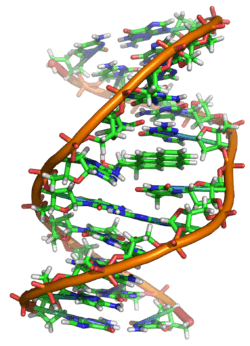DNA adduct
In molecular genetics, a DNA adduct is a segment of DNA bound to a cancer-causing chemical. This process could be the start of a cancerous cell, or carcinogenesis. DNA adducts in scientific experiments are used as biomarkers of exposure[1] and as such are themselves measured to reflect quantitatively, for comparison, the amount of carcinogen exposure to the subject organism, for example rats or other living animals. Under experimental conditions for study, such DNA adducts are induced by known carcinogens, of which commonly used is DMBA (7,12-dimethylbenz(a)anthracene). For example, the term "DMBA-DNA adduct" in a scientific journal refers to a piece of DNA that has DMBA attached to it. The presence of such an adduct indicates prior exposure to a potential carcinogen, but does not by itself indicate the presence of cancer in the subject animal.[2]

Examples

Chemicals that form DNA adducts include:
- acetaldehyde, a significant constituent of tobacco smoke
- cisplatin, which binds to DNA and causes crosslinking, leading to death of the cell
- DMBA (7,12-dimethylbenz(a)anthracene)
- malondialdehyde, a naturally occurring product of lipid peroxidation[3]
DNA adducts include:
- etheno-DNA adducts: 1,N(6)-etheno-2'-deoxyadenosine (epsilondA) and 3,N(4)-etheno-2'-deoxycytidine (epsilondC)
By-products include:
- M1G, a by-product of base excision repair (BER) of a specific type of DNA adduct called M1dG.
DNA damage
When a chemical binds to DNA, the DNA becomes damaged, and proper and complete replication cannot occur to make the normal intended cell. This could be the start of a mutation, or mutagenesis. Without effective DNA repair, which happens naturally under normal circumstances, this can lead to carcinogenesis, the beginnings of cancer.
Adducts due to beef diet
Human consumption of more than 2.5–3.5 oz (70–100 g) of red meat (beef, lamb or pork) a day increases the risk of colon cancer, but eating chicken does not have this risk.[4][5] The increased risk of colon cancer from red meat may be due to higher increases in DNA adducts from digestion of red meat. When rats were fed either beef or chicken, three types of DNA adducts in colon tissue were significantly higher after consumption of beef than after consumption of chicken.[6] These adducts were a type of methyl-cytosine (possibly N3-methyl-cytosine), an adduct of two malondialdehyde molecules with guanine, and carboxyl-adenine. DNA adducts are a type of DNA damage. DNA damage is considered to be the primary cause of carcinogenesis.[7]
See also
- Adduct
- Adductomics
- Intercalation (biochemistry)
References
- La, DK; Swenberg, JA (1996). "DNA adducts: biological markers of exposure and potential applications to risk assessment". Mutation Research/Reviews in Genetic Toxicology. 365 (1–3): 129–146. doi:10.1016/s0165-1110(96)90017-2. PMID 8898994.
- Farmer, P. "Biomarkers of exposure and effect for environmental carcinogens, and their applicability to human molecular epidemiological studies". Public Health Applications of Human Biomonitoring. U.S. EPA. Retrieved 22 June 2011.
- Marnett LJ (March 1999). "Lipid peroxidation-DNA damage by malondialdehyde". Mutat. Res. 424 (1–2): 83–95. doi:10.1016/s0027-5107(99)00010-x. PMID 10064852.
- Aykan NF (2015). "Red Meat and Colorectal Cancer". Oncol Rev. 9 (1): 288. doi:10.4081/oncol.2015.288. PMC 4698595. PMID 26779313.
- Wolk A (2017). "Potential health hazards of eating red meat". J. Intern. Med. 281 (2): 106–122. doi:10.1111/joim.12543. PMID 27597529.
- Hemeryck LY, Van Hecke T, Vossen E, De Smet S, Vanhaecke L (2017). "DNA adductomics to study the genotoxic effects of red meat consumption with and without added animal fat in rats". Food Chem. 230: 378–387. doi:10.1016/j.foodchem.2017.02.129. PMID 28407925.
- Kastan MB (April 2008). "DNA damage responses: mechanisms and roles in human disease: 2007 G.H.A. Clowes Memorial Award Lecture". Molecular Cancer Research. 6 (4): 517–24. doi:10.1158/1541-7786.MCR-08-0020. PMID 18403632.